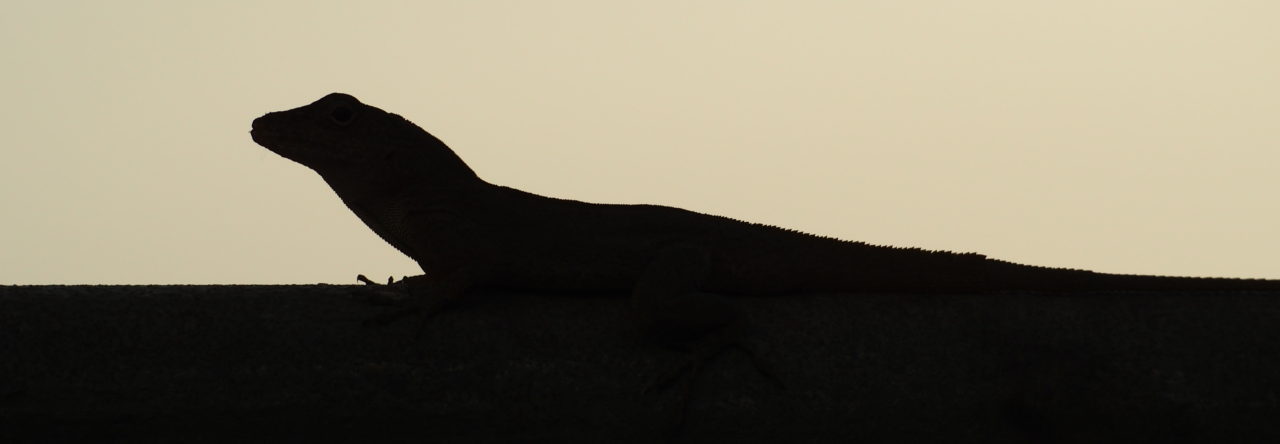
Dr. Jenna Pruett with the study organism from her SICB talk, Anolis sagrei .
While nesting is ubiquitous across taxa, Dr. Jenna Pruett is interested (like many of us on this site) in non-avian reptiles. Dr. Pruett is currently and NSF Postdoctoral Fellow at University of Colorado – Boulder under Dr. Ambika Kamath and completed her Ph.D. with Dr. Daniel Warner at Auburn University in 2021. For her doctoral work, Dr. Pruett studied nesting behavior in the Cuban brown anole (Anolis sagrei). She found that A. sagrei females tend to nest on the ground, under cover objects (e.g., under rocks), and in areas with high soil moisture and lower temperatures than compared to ambient surroundings. Interestingly, she found that these nest sites were correlated with positive effects on offspring survival.
At SICB 2022, Dr. Pruett discussed a chapter of dissertation research where she was interested in other environmental variables that might influence nesting behavior, such as the presence of predators. The northern curly-tailed lizard (Leiocephalus carinatus) has a shared evolutionary history (i.e., native to Bahamas, invasive in Florida) with A. sagrei. Additionally, A. sagrei is considered a trunk-ground species and L. carinatus is mostly ground-dwelling. Other research suggests that when L. carinatus is present, individual A. sagrei tend to perch higher in the canopy and an increase in mortality is observed (particularly for females).

Dr. Pruett’s experimental set-up from this project.
To address whether predation risk influences A. sagrei nesting behavior, Dr. Pruett designed walk-in cages that were visually separated from each other and contained two nesting options for females: (1) a nest pot above the ground and (2) a nest pot on the ground in a cage with L. carinatus. Some of these cages contained a predator, while some did not. She predicted that females would prefer to nest in above-ground areas when predators were present.
Dr. Pruett found that overall, females tended to prefer laying eggs on the ground prior to predator presence. After predators were added to cages, there was a distinct difference in nesting behavior in cages with and without a predator (i.e., over 50% of eggs laid were above ground when a predator was present). Lastly, when predators were removed, there was a continued upward trend of laying eggs above ground in both treatments. Dr. Pruett suggests that this might result because above-ground pots are a relatively pristine environment to nest, and that if given that option under natural conditions, females might tend to nest above ground as well. Additionally, the above-ground pot may have also gotten more sunlight and more/less moisture that might account for female preference. Dr. Pruett also adds that lizards in cages that were without a predator may have sensed that L. carinatus were in the area (i.e., through mechanisms other than visual) that led them to nest higher.
Dr. Pruett concluded her SICB talk with three remarks: 1) there is an effect of predator presence on A. sagrei nesting behavior, 2) there is an increased preference for above-ground nests in both treatment groups that could be due to other environmental factors, and 3) there need to be more studies on anole nesting, which is a critical component of reproduction, but is understudied in many species. Dr. Pruett is one of the world’s leading researchers in anole nesting behavior and I would highly encourage you to reach out to her with any questions!
“SICB has provided invaluable networking opportunities for me! I met my PhD advisor there, and each year it’s an opportunity to see current research and exchange exciting ideas,” Dr. Pruett says of SICB.
Check out Dr. Pruett’s talk here! Check out Dr. Pruett’s twitter page here!














 Image 2. SEM image of A. sagrei egg at 397X magnification.
Image 2. SEM image of A. sagrei egg at 397X magnification. Image 3. SEM image of A. sagrei egg at 1,500X magnification.
Image 3. SEM image of A. sagrei egg at 1,500X magnification.  Image 4. SEM image of A. sagrei egg at 1,5700X magnification.
Image 4. SEM image of A. sagrei egg at 1,5700X magnification.